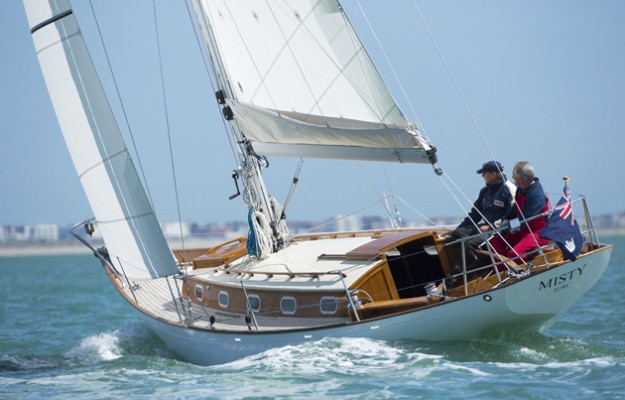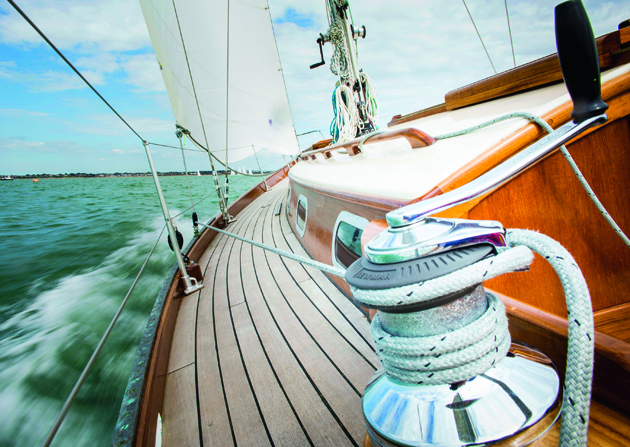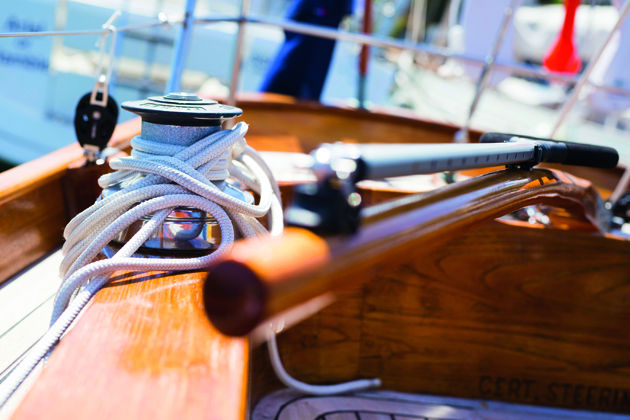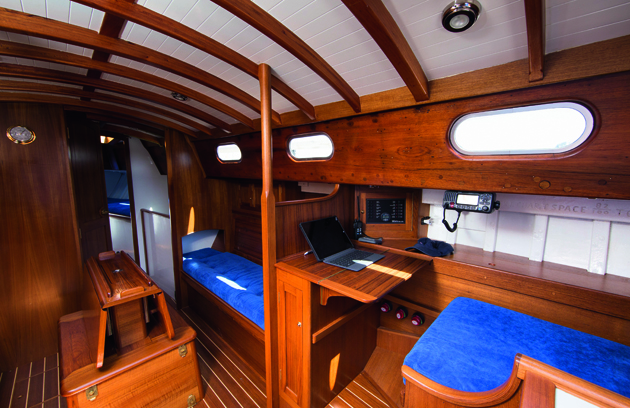A 37-footer from the 1960s with racing pedigree, Misty was reworked for the classic circuit. Rupert Holmes reports on her extensive refit
“Initially I noticed she had beautiful underwater lines,” says Card. “I didn’t know who her owner was, so I put a business card with a note on her rudder and got a call back three months later.” In the meantime, Card had been researching Misty’s history, discovering David Cheverton designed her in 1962 and that she was built in Cowes by Clare Lallow for Franklin Ratsey Woodroffe of renowned local sailmaker Ratsey and Lapthorn.
However, of more interest to Card was her racing pedigree, which turned out to be very interesting. Misty had been designed as an updated – and hopefully faster – version of one of Cheverton’s most successful designs, Danegeld. Launched in 1958, this was a boat that achieved 21 podium results, including 15 wins, in just 22 races during her first full season.
At 37ft, with a 25ft static waterline length, Misty was slightly larger in terms of LOA and therefore also heavier than Danegeld. Nevertheless, Cheverton firmly believed Misty would be faster than the older boat under the RORC rating rule that was used for offshore racing at the time.
Perhaps surprisingly, Misty was not extensively campaigned in her youth – she was used more frequently as a demonstrator for her owner’s business. However, she certainly showed good promise in the races she did enter, with results including 16th and 25th in the 1963 and 1965 Fastnet Races, along with a string of 2nd, 3rd and 4th places in her class in the Round the Island Race from 1962-66.
Although there were no sisterships to Misty, Cheverton also designed another yacht with very similar lines, but this was a significantly larger 55-footer called Chevalier, which is possibly the last yacht he designed before focusing his attention on workboats.
Remodelling Misty’s rig
Misty’s original mast – one of the earliest aluminium spars and fabricated from rolled metal – had been condemned. This offered an opportunity to investigate the possibility of optimising the new rig for IRC racing. Card has been careful to retain, and even enhance, the boat’s classic lines as much as possible, but he felt that the fact that she originally had an aluminium mast give more scope to update the rig, while remaining faithful to her original appearance.
“Had the original been a wooden spar, we might have looked for a different solution,” says Card, “but given that it was an alloy mast, there was no need to preserve a more traditional style with a wooden mast.”
Having discovered the racing side of Misty’s heritage, Card turned to Allen Clarke of the famed Owen Clarke design partnership, to optimise Misty’s rig for IRC racing. ”Although their work is mainly in contemporary grand-prix yachts, I knew Allen also has an enthusiasm for classic boats,” Card explains.
It soon became clear that the rig, as originally drawn, was much too short by today’s standards, especially for the boat’s eight-tonne displacement, so before any conclusions could be drawn, more data about the boat’s hull shape, stability and weight distribution was needed.
Card had been lucky to get hold of David Cheverton’s original plans, thanks to a former employee who rescued them from a skip when the company moved out of the yacht market. Unfortunately, these didn’t provide enough detail and there was no guarantee the builders had made an exact representation of the plans at full size.
Exact hull shape
However, one of Card’s businesses is in precision laser scanning of large objects. Marcus Evans, a former boat-builder, took the equipment to Scotland, where he scanned Misty’s hull and deck. From that data he was able to create a CAD surface model accurate to within two millimetres.
This enabled the exact hull shape, ballast weight and location and so on to be input into Owen Clarke’s velocity prediction software. Card says this was an important part of the story. Evans adds: “Both sides were very symmetrical.”
Historical weather data for various target events and venues was analysed to establish performance predictions. Initially Owen Clarke developed both masthead and fractional rigs, submitting trial IRC certificates for both. After cross-referencing the corrected time and predicted performance for a range of conditions, the designers ended up developing a fractional rig that optimised both the IRC rating and the predicted performance around the racecourse.
As it turns out, structural considerations became one of the main limiting factors on rig size. Unlike most traditionally built carvel wooden yachts, the gap between Misty’s planks had originally been splined and glued rather than caulked, in much the same way as the XOD fleet today.
While this produces a much stiffer structure, it was nevertheless determined that the key limitation on the size of the rig would be the stiffness of the structure, which put an effective limit on the size of the sail plan.
The result is a rig with a mast height 15.4m (50ft 6in) above the waterline. This is 2.4m (8ft) taller than the original and 1.3m taller than a revised rig that David Cheverton drew for the boat in 1964, which was never fitted. The new spar is also a more modern design than the original, significantly lighter and with two pairs of swept-back spreaders.
Misty’s IRC rating is just 0.874, little more than 20 points above that of Danegeld, despite her greater LOA and significantly bigger rig. Card believes she has the potential to be in the top four in her class in the JP Morgan Asset Management Round the Island Race. Given a breezy day, with lots of close reaching legs, in which Misty’s long waterline length relative to her rating would be a big bonus, he could be right.
A full restoration
However, before Misty could sail there was also the matter of a full restoration. The work was done to a very high standard by Adam Way’s yard in Lochgilphead in Scotland.
Many important parts of the structure had suffered significant degradation, although elements of the boat were still in sound condition, including ribs, stringers, a few deck beams and most of the planking. Each of the three original chainplates on each side had been leaking, so the planking in that area was badly damaged and had to be replaced.
Similarly, the original teak deck could not be saved and was replaced with 13mm teak over ply. New deck beams were laminated from mahogany, although those for the side decks were retained. In addition, the transom had suffered over the decades from inadequate ventilation and as a result had extensive rot and needed to be replaced.
Perhaps surprisingly, Misty’s original interior was not of a particularly high quality. The rebuild therefore included a new interior, which broadly follows the simple and pragmatic traditional layout of the original, but is of higher quality and offers a significantly better level of comfort within the limited hull volume available.









